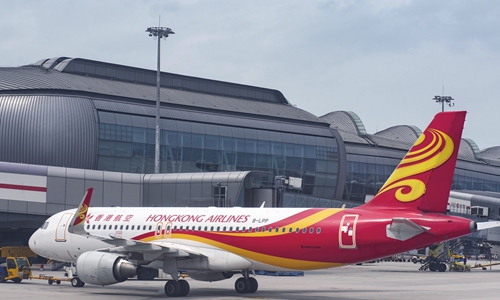
A Hong Kong Airlines plane docks at the Hong Kong International Airport runway in February. Photo: VCG
The trapped Hong Kong Airlines, which was at risk of having its license revoked, seems to be safe now.
The airlines said in an e-mail reply to the Global Times on Wednesday that after urgent consultations, the company has drawn up an initial cash injection plan to meet regulatory requirements. Services will return to normal as soon as funds arrive.
The Air Transport Licensing Authority (ATLA) of Hong Kong warned on Monday that the airline's financial position had deteriorated rapidly. ATLA said Hong Kong Airlines must, by Saturday, ensure a cash injection plan or face the risk of the suspension or loss of its operating license in the region.
The carrier, partly owned by the cash-strapped Chinese conglomerate HNA Group, said all relevant stakeholders, including shareholders and management, have paid particular attention to this issue. But the company did not disclose the source of the funds.
Reuters reported that Hong Kong Airlines was in a precarious financial position even before the unrest. The unlisted company told shareholders in April it had lost HK$3 billion ($383.39 million) in 2018, according to people close to the matter.
The airline has announced several capacity cuts including the suspension of flights to Vancouver, Ho Chi Minh City and North China's Tianjin Municipality.
The fate of the Hong Kong Airlines is a microcosm of Hong Kong's business performance, as months of unrelenting riots have hurt the aviation industry.
It is clearly that the fate of local carriers in Hong Kong is impacted by the riots, but where the way out should depend on rising demand, instead of the cash injection.
Aside from Hong Kong Airlines, the Cathay Pacific Group released combined Cathay Pacific and Cathay Dragon traffic figures for October 2019 that show decreases in the number of passengers carried and the amount of cargo compared to the same month in 2018. Passengers and cargo in the group have consistently decreased for months.
The company said demand for travel into Hong Kong in October remained weak with inbound passenger traffic seeing a year-on-year decline of 35 percent, consistent with the trend seen in both August and September. The drop in outbound Hong Kong traffic was 13 percent in October, similar to the trend of the past two months.
The group even expects their second half financial results will be significantly below those of the first-half, and the short-term outlook remains uncertain.
Data from the Hong Kong Tourism Board showed that visitor arrivals in October slumped 43.7 percent year-on-year, with tourist arrivals from the Chinese mainland down 45.9 percent year-on-year.
The gloomy outlook of Hong Kong aviation industry is starkly contrasted with activity in neighboring airports.
Macao International Airport said on Wednesday that it is near a yearly passenger throughput of 10 million as the airport has handled a total of more than 8.7 million passengers and more than 71,000 flights in the first 11 months of this year, a 16 percent and 19 percent increase over the same period last year.
Shenzhen International Airport also witnessed more than 4 million international passengers in the first 10 months, up 32 percent year-on-year.

